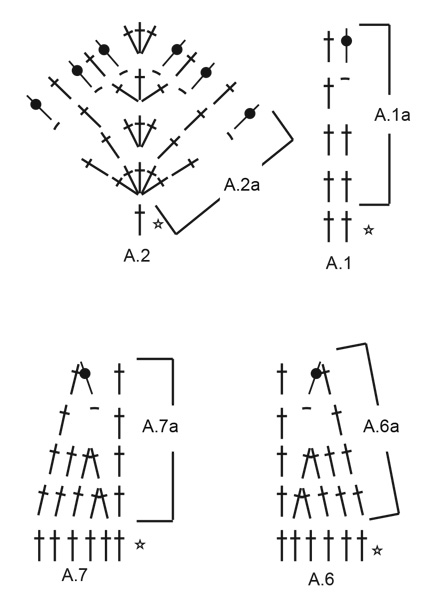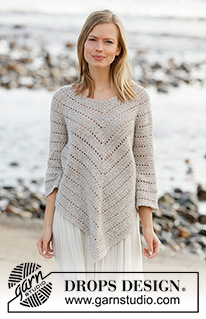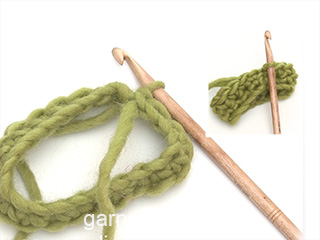Hey June |
||||||||||||||||||||||
 |
 |
|||||||||||||||||||||
Crocheted poncho jumper with raglan in DROPS Sky. Piece is crocheted top down at an angle, A-shape and lace pattern. Size XS–XXL.
DROPS 213-35 |
||||||||||||||||||||||
|
---------------------------------------------------------- EXPLANATION FOR THE PATTERN: ---------------------------------------------------------- CHAIN STITCH: If you work at the end of crochet hook the chain stitch will often be too tight 1 chain stitch should be just as long as 1 treble crochet is wide. PATTERN: See diagrams A.1 to A.7. CROCHET INFORMATION: At beginning of every round with treble crochet replace first treble crochet with 3 chain stitches. Finish round with 1 slip stitch in 3rd chain stitch at beginning of round. Round beginning with 1 chain stitch in the diagrams, begins with 3 chain stitches (these will replace last treble crochet on round). Finish round with 1 slip stitch in 3rd chain stitch at beginning of round. On every round with double crochets replace first double crochet with 1 chain stitch. Finish round with 1 slip stitch in first chain stitch at beginning of round. INCREASE TIP: Work 2 treble crochets in same stitches (= 1 treble crochet increased). ---------------------------------------------------------- START THE PIECE HERE: ---------------------------------------------------------- JUMPER - SHORT OVERVIEW OF THE PIECE: Work in the round top down. First work a yoke. Then divide the piece into body and sleeves and continue in the round separately. Finish with an edge around the neckline. YOKE: Work 96-96-104-104-112-112 chain stitches - read CHAIN STITCHES, on hook size 4.5 mm with Sky and form a ring with 1 slip stitch in first chain stitch. Work 1 treble crochet in every chain stitch and increase 16-16-12-16-16-24 treble crochets evenly – read CROCHET INFORMATION and INCREASE TIP = 112-112-116-120-128-136 treble crochets. WORK PATTERN A.1 TO A.5 AS FOLLOWS: Round begins in transition between left sleeve and back piece. Work * A.1a (= 2 treble crochets) over 22-22-23-24-26-28 treble crochets, A.2a (= 1 treble crochet = mid back/mid front), A.3a (= 2 treble crochets) over 22-22-23-24-26-28 treble crochets (= back piece/front piece), A.4a (= 1 treble crochet), A.3a over 8 treble crochets, A.5a (= 2 treble crochets = sleeve) *, work from *-* 2 times in total. REMEMBER THE CROCHET TENSION! On 4th round increase (in addition to diagrams) 0-2-2-4-4-6 treble crochets evenly on each front piece/back piece on each side of middle stitch (i.e. 0-4-4-8-8-12 stitches increased in total on each front piece/back piece) and 0-2-2-2-2-4 treble crochets evenly on each sleeve (= 0-12-12-20-20-32 stitches increased evenly and 40 stitches increased in A.2a/A.4a/A.5a) = 152-164-168-180-188-208 stitches. Repeat pattern vertically. I.e. work A.2a over the middle treble crochet from previous repetition. Every time it is repeated there are 6 treble crochets more on each side of middle stitch, which are worked in pattern A.1a/A.3a. Work A.4a over the first treble crochet from previous repetition, work the remaining 4 stitches in pattern A.3a. Work A.5a over the last 2 treble crochets from previous repetition, work the remaining stitches in pattern A.3a. I.e. increase 8 stitches in total on each sleeve and 12 stitches on front piece/back piece for every repetition of pattern vertically (= 40 stitches increased in total). On 8th round (i.e. last round of 2nd repetitions) increase (in addition to diagrams) 0-2-2-4-4-6 treble crochets evenly on each front piece/back piece on each side of middle stitch (i.e. 0-4-4-8-8-12 stitches increased in total on each front piece/back piece) and 0-2-2-2-2-4 treble crochets evenly on each sleeve (= 0-12-12-20-20-32 stitches increased evenly and 40 stitches increased in A.2a/A.4a/A.5a) = 192-216-220-240-248-280 stitches. Then repeat pattern vertically. When 15-15-17-19-21-21 rounds have been worked in total, work 1 more round as before but increase 1 stitch on each sleeve = 274-298-322-362-390-422 stitches. Piece measures approx. 20-20-23-25-28-28 cm. Insert 4 markers in piece without working as follows: Insert 1 marker at the beginning of round, insert 1 marker after 93-101-109-125-135-147 treble crochets (= back piece), insert 1 marker after 44-48-52-56-60-64 treble crochets (= right sleeve), insert 1 marker after 93-101-109-125-135-147 treble crochets (= front piece), the remaining stitch on round (= 44-48-52-56-60-64 treble crochets) are left sleeve. These markers mark where yoke is divided later. If the crochet tension is not correct vertically continue to work as explained below until piece measures 20-20-23-25-28-28 cm but the increase will continue and the body will be a bit wider. Work as follows if needed: Continue with A.2a over middle stitch(es) (depending on which round you are working) on front piece/back piece and A.1a/A.3a over the remaining stitches. When piece measures 20-20-23-25-28-28 cm, divide piece for body and sleeves as follows: Work as before over stitches on back piece until marker thread, work 8 chain stitches, skip stitches between the 2 marker threads (= sleeve), work as before over stitches on front piece until next marker thread, work 8 chain stitches, skip the last stitches between marker threads (= sleeve). BODY: Insert 1 marker thread in the middle of the 8 stitches under each sleeve. Move the marker threads upwards, decrease on each side of these. Continue pattern as before, i.e. increase mid front and mid back while decreasing stitches under each sleeve by working diagram A.6a and A.7a as follows: Work until stitches in A.6a remain before marker thread (this is according to where pattern was casted off for body/sleeves), work A.6a, work A.7a. Work like this on each side of every marker thread. Decrease stitches in A.6a and A.7a and increase stitches in A.2a mid front/mid back. When 1 repetition / 4 rows have been worked vertically, 16 stitches have been decreased and 24 stitches have been increased, i.e. increase 8 stitches per repetition. Continue pattern like this until piece measures 24 cm from where piece was divided, adjust to finish with 2 rounds with only treble crochets - or work to desired measurements. SLEEVES: Fasten strand with 1 slip stitch in 4th chain stitch under sleeve, work 1 treble crochet in each of the 4 chain stitches under sleeve, work pattern as before over the 44-48-52-56-60-64 stitches skipped for sleeve and finish with 1 treble crochet in each of the last 4 chain stitches under sleeve = 52-56-60-64-68-72 treble crochets. Work until A.3a measures 32-33-31-30-27-28 cm from division (or desired length– NOTE!: Shorter measurements in the larger sizes because of wider neck and longer yoke) - adjust after 2 round with only treble crochets. Then work 1 edge around the sleeve as follows: Work * 1 double crochet, 3 chain stitches, skip approx. 1 cm *, work from *-* around the entire sleeve, adjust to finish with 3 chain stitches and 1 slip stitch in first double crochet. Cut and fasten the yarn. Work the other sleeve the same way. NECK EDGE: Crochet an edge around the neck as follows: Begin mid on top of shoulder, fasten strand with 1 slip stitch in 1st stitch. Work * 1 double crochet in next stitch, 3 chain stitches, skip approx. 1 cm *, work from *-* around the neck like this, adjust to finish round with 3 chain stitches and 1 slip stitch in first double crochet. Make sure edge is not too tight at the neck, skip fewer stitches if needed. Fasten off. |
||||||||||||||||||||||
Diagram explanations |
||||||||||||||||||||||
|
||||||||||||||||||||||

|
||||||||||||||||||||||

|
||||||||||||||||||||||

|
||||||||||||||||||||||
|
Have you made this or any other of our designs? Tag your pictures in social media with #dropsdesign so we can see them! Do you need help with this pattern?You'll find tutorial videos, a Comments/Questions area and more by visiting the pattern on garnstudio.com. © 1982-2024 DROPS Design A/S. We reserve all rights. This document, including all its sub-sections, has copyrights. Read more about what you can do with our patterns at the bottom of each pattern on our site. |
||||||||||||||||||||||


















































Comments / Questions (61)
This has to be the most confusing pattern I have ever tried to use. I'm an experienced crocheter and this is just gobbledegook. I appreciate its free but its terrible. I would've given up making it if it hadn't been a requested item. Ended up, having to re write it. Can't recommend.
09.06.2022 - 13:35Salve! Sto eseguendo questo modello nella taglia XL. Parto da 112 catenelle e alla fine dopo gli aumenti ho 128 maglie alte. Fin qui tutto bene. Inizio a seguire i diagrammi e quindi ad ogni giro aumento 60 maglie, quindi avrò 188 m, poi 248 m e così via. Al 16° giro ho 368 m. Come faccio al 21° giro ad avere 390 m??? Cosa non ho capito? Grazie
02.05.2022 - 15:45DROPS Design answered:
Buonasera Nonnalorenza, oltre agli aumenti del diagramma ci sono anche gli aumenti indicati ad esempio sul 4° e 8° giro. Buon lavoro!
07.05.2022 - 17:15Jag ser på bilden att det finns hålmaskor virkade. Vart finns denna beskrivning? Hur får man till dessa små hål?
11.04.2022 - 11:55DROPS Design answered:
Hei Satu. Når du hekler etter diagrammene og da hekler omgangen med luftmasker, vil disse luftmaskene skape hullmønstret. Du gjentar diagrammene i høyden og da skapes det hullmønster på hver 4. omgang. mvh DROPS Design
19.04.2022 - 09:57Scusi, come mai al primo giro al diagramma A2a dice di lavorare una maglia alta quando sul grafico indica 5 maglie alte? grazie
03.02.2022 - 11:45DROPS Design answered:
Buonasera Gina, vanno lavorate 5 m.a in 1 m.a. Buon lavoro!
05.02.2022 - 20:48Ich arbeite für Größe XL für Passe. Muss ich ab Runde 4 insgesamt 40 Maschen zusätzlich zu den Zunahmen durch das Muster zunehmen oder zählen die zugenommenen Mädchen von A2,4 und 5 mit?
04.12.2021 - 18:32DROPS Design answered:
Liebe Bettina, diese Zunahmen werden zusätlich zun den Zunahmen in Diagram gehäkelt. Viel Spaß beim häkeln!
06.12.2021 - 07:56Drops crochet pattern Hey June 213-35, I have reached where the piece is split for the sleeves. I have worked the row where the sleeve sets are skipped with a chain of 8 sets. Do I continue with the next row working trebles across the chain of 8 sts (sleeve), or is it now worked with the front/back and back/front pieces worked separately
17.09.2021 - 22:45DROPS Design answered:
Dear Judith, yes, continue the pattern under the sleeves (on the 8 stitches you made), and from here the pieces (body and the two sleeves) are knitted separately. Happy Stitching!
19.09.2021 - 00:37I am making the XS size and have a problem with the number of stitches I need to increase. I think the pattern is saying to increase 16 on the first round (after the foundation chain), then 12 in the next round (increasing 8 in A2, 2 in A4 and 2 in A5), followed by 8 in the next round (4 in A2, 2 in A4 and 2 in A5). I am 20 stitches short - the pattern says I should have 152 stitches and I only have 132. Where have I gone wrong? Thanks for any help you can give.
02.06.2021 - 16:04DROPS Design answered:
Dear Susan, at the end of row 2 of the diagrams you have 132 stitches (= 11 sts in A.2, 4 sts in A.4a, 5 sts in A.5a) - then at the end of row 3 of the diagram you will have 152 sts (= 13 sts in A.2, 5 sts in A.4a, 6 sts in A.5a). Hope this will help. Happy crocheting!
02.06.2021 - 16:24Cosa si intende lavorare 1 altro giro come prima dopo aver lavorato 19 giri? Bisogna eseguire due giri identici senza seguire i diagrammi? Grazie
22.05.2021 - 22:04DROPS Design answered:
Buonasera Antonella, deve lavorare un altro giro con i motivi in cui aumentare 1 maglia su ogni spalla. Buon lavoro!
22.05.2021 - 22:52Hej Jag är på fram-och bakstycke. När jag gjort hela A6 och a7 en gång vad ska jag göra då? Det verkar konstigt att börja om, dvs att börja minska igen. Jag har ju inte så många maskor som det ska vara från varv 1. Varifrån är delningen? Dvs därifrån man ska mäta 24 cm.
15.04.2021 - 19:43DROPS Design answered:
Hej Jeanette, du kan se på måleskitsen hvorfra du skal måle de 24 cm. När 1 rapport / 4 varv har virkats på höjden har det minskats 16 maskor och ökats 24 maskor, dvs det ökas 8 maskor per repetition.
28.04.2021 - 15:32Bonjour, je fais la taille M. merci de m'aider.
31.03.2021 - 23:33DROPS Design answered:
Bonjour Ginette, tour 4: vous travaillez selon les diagrammes, les mailles sont augmentees en A.2a, A.4a et A.5a> cela veut dire que vous augmentez les mailles a chaque raglan et au milieu dos et milieu devant. A la fin du 4eme tour vous devriez avoir 156 mailles. Le meme tour vous augmenez aussi 4 brides à intervalles réguliers sur les mailles du devant et 4 sur le dos (sur les mailles de A.1a et A.3a) et 2 brides à intervalles réguliers sur chaque manche (4 mailles augmentees) > 4+4+2+2=12 mailles supplementaires. Au total 168 mailles.
01.04.2021 - 14:06